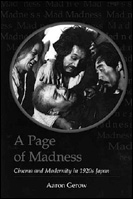A Page of Madness: Cinema and Modernity in 1920s Japan

- Author
- Aaron Gerow
- Publisher
- Center for Japanese Studies, University of Michigan
- Published
- 14 March 2011
by Alexander Jacoby
In the first chapter of Aaron Gerow’s remarkable study of Teinosuke Kinugasa’s classic Japanese silent film A Page of Madness, we learn that the correct transliteration of the Japanese title is not (as almost all scholars of Japanese cinema, include myself, have listed it) “Kurutta Ippeiji”, but rather, “Kurutta Ichipeiji” – a reading confirmed by contemporary documentation.
This correction typifies not only the author’s attention to detail, but also his refusal to swallow established assumptions. Over the course of the book, he proceeds to challenge other misconceptions about the film: for instance, the idea that it was originally shown without a benshi (in fact, Musei Tokugawa provided an acclaimed narration), and the notion that it was a low-budget, independent art film (in reality, a major studio, Shochiku, invested in the production, and the budget of 20,000 yen was twice that of the commercial jidai-geki Kinugasa would go on to make at that studio). Drawing on a wealth of original material, most of it unavailable in translation, Gerow sets the story straight, providing what is likely to remain the definitive study of this early masterpiece of Japanese film.
Though little more than a hundred pages long, Gerow’s book appears to be a fairly comprehensive account of the film’s production and reception, ranging from the cultural, historical and cinematic background to the details of the filming and editing to the responses of critics both at the time of the film’s original release and since its re-release in the early 1970s. Stressing the variety of these responses, Gerow himself refuses to attempt a “definitive” interpretation of the film.
In truth, he suggests, this is an impossible task, because there is not just one “Page of Madness”. The canonical script, ostensibly by the celebrated novelist Yasunari Kawabata and published under his name, is not the genuine screenplay; Kawabata’s actual contribution appears to have been slight, and his script “is just one of the many texts floating around that film, another version of a movie with many versions.” The surviving print, which runs about an hour at usual projection speeds, is considerably shorter than was the original, which appears to have contained a number of more conventional narrative scenes; it seems likely that Kinugasa himself, after the chance rediscovery of the film in 1970, actually re-edited it in order to reduce the film’s narrative comprehensibility and thus conform more precisely with the notion of an avant-garde film current at the time. In this way, the director himself may have participated in the post hoc construction of the film as a unique modernist text. In fact, while the film was produced, in 1926, in the context of a flourishing international avant-garde, it nevertheless drew on popular Japanese narrative modes and conventions (eg, those of shinpa theatre); furthermore, it is likely that the benshi commentary would have clarified many of the film’s ambiguities for its original audience. Evidence for this blend of popular and avant-garde modes is provided by the fact that contemporary critics were divided between those who praised the film’s modernity and those who found it a relatively conventional melodrama.
Thus, while not denying the individuality of A Page of Madness, Gerow persuasively situates it within the traditions of Japanese studio filmmaking of the 1920s. So much of Japan’s silent-era output has been lost that the surviving films have been effectively decontextualised; Gerow’s account succeeds brilliantly in restoring that context.
One evidently deliberate, but still regrettable, omission from this remarkable book is a sustained and detailed critical interpretation of the film by the author himself. Gerow’s reluctance to advance such an interpretation could perhaps be seen to follow logically on from his assertion that there is no definitive text and that, partly as a consequence, interpretations of the film are likely to be almost infinitely variable. But almost all critics would agree now that there is no such thing as a “correct” or “definitive” interpretation of a literary or cinematic text. This does not mean that the process of interpreting a film is unhelpful, and indeed, Gerow’s close reading of specific scenes is generally suggestive – just as his earlier published work on Takeshi Kitano has conclusively demonstrated that his interpretations are subtle, persuasive, informative, and able to shed light on both text and context. One might wish for another chapter or chapters that would devote the same level of close textual analysis to Kinugasa’s film. Still, it is pleasant to be able to write that a book’s major flaw is that it is too short, and Gerow’s analysis of the production history and reception of this remarkable film is unlikely to be bettered.